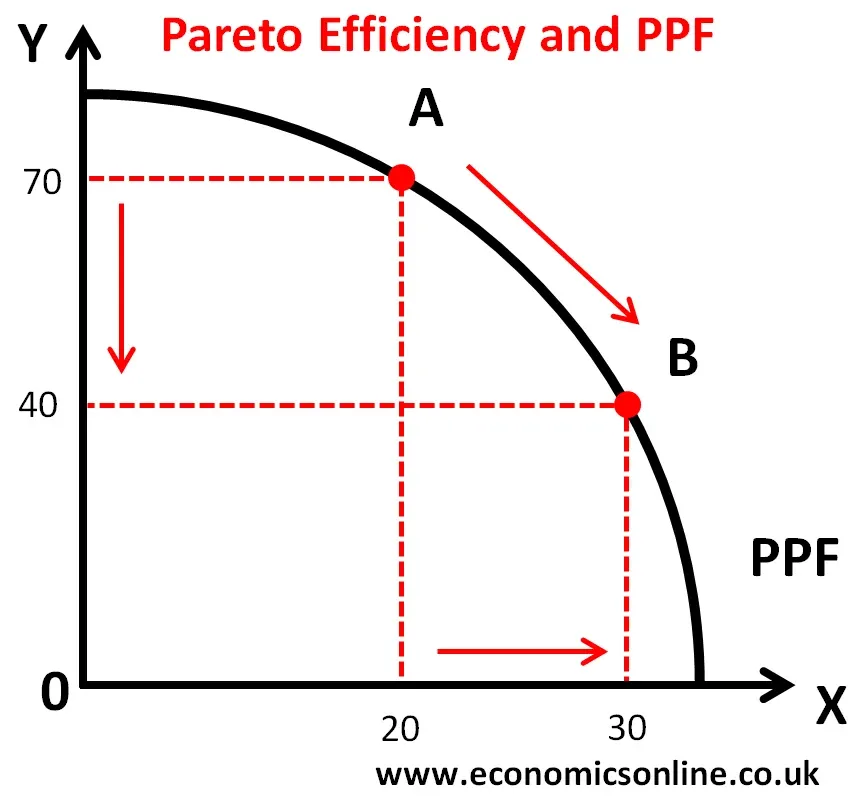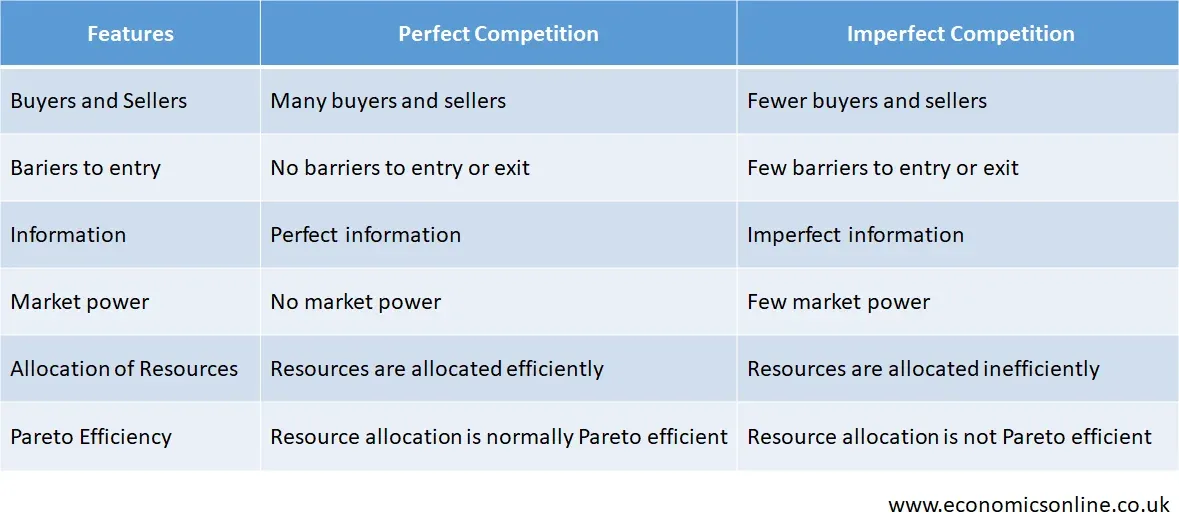
An image of a light bulb.
Pareto Efficiency
What is Pareto Efficiency?
Pareto efficiency, also known as Pareto optimality, is a concept in economics that defines a state in which no individual can be made better off without making at least one other individual worse off.
In other words, an allocation of resources is considered Pareto efficient when it is impossible to reallocate resources to make any individual better off without reducing the well-being of someone else.
Pareto efficiency was named after the Italian economist Vilfredo Pareto and is often used as a benchmark for evaluating the efficiency and fairness of resource allocations in economic and social systems.
Understanding Pareto Efficiency with an Example
Let's say you and your friend are sharing a pizza. You both have different preferences for the toppings; you prefer pepperoni, and your friend prefers mushrooms. The initial allocation of the pizza has half of it topped with pepperoni and the other half with mushrooms.
Now, let's imagine that you and your friend can communicate and make trades. If you both agree to swap some slices, where you give your friend a slice with pepperoni in exchange for a slice with mushrooms, both of you would be better off. This new allocation would be Pareto efficient because there is no way to further reallocate the slices to make one of you better off without making the other worse off.
In this example, Pareto efficiency is achieved when there is no possible trade or reallocation that can make one person better off without making the other worse off. It demonstrates how resource allocations can be optimised to maximise overall satisfaction without disadvantaging anyone involved.
What is Pareto Improvement?
A Pareto improvement occurs when a change in resource allocation makes at least one individual better off without making anyone worse off.
Pareto Improvemeent: Example
Imagine a scenario where there are two friends, Alice and Bob, who are sharing a bag of candy. Initially, Alice has five candies, and Bob has three candies.
If Alice and Bob agree to trade two candies, where Alice gives two of her candies to Bob, both Alice and Bob will be better off. Alice now has 3 candies, just like Bob, and Bob now has 5 candies, just like Alice. This change in allocation results in a Pareto improvement because both individuals are better off without making the other worse off.
In this example, the trade of candies creates a win-win situation, leading to a Pareto improvement by increasing the overall satisfaction of both Alice and Bob.
Applying Pareto Efficiency in Real-Life Scenarios
In practise, Pareto efficiency is often used as a guiding principle in various fields to evaluate and optimise resource allocations. Here are a few examples:
Economic Policy
When designing economic policies, governments try to achieve Pareto efficiency to ensure that the distribution of resources maximises overall societal welfare without disadvantaging any particular group.
Environmental Conservation
Pareto efficiency can be applied to environmental decision-making. One example is when governments try to find solutions that minimise pollution and maximise conservation efforts without harming economic growth or individual livelihoods.
Healthcare
In healthcare, Pareto efficiency can be used to assess the allocation of medical resources, such as organ transplants or access to healthcare services, to ensure that the distribution is fair and maximises health outcomes for the population.
Urban Planning
Urban planners consider Pareto efficiency when designing cities to optimise the allocation of resources such as transportation infrastructure, public spaces, and housing, aiming to benefit as many residents as possible without causing harm to any particular group.
Pareto Efficiency in the Context of Market Failure
Market failure occurs when the allocation of resources in an economy leads to an outcome that is not Pareto efficient.
In other words, the free market mechanism fails to efficiently allocate resources to maximise overall societal well-being.
There are several reasons for market failure, including:
Externalities
These are the costs or benefits that affect individuals not directly involved in economic decisions about production and consumption. Those goods creating positive externalities (benefits) like education can be underprovided, while those creating negative externalities (costs) like pollution can be overproduced.
Market Power
When a single buyer or seller has substantial influence over the market, they can distort prices and quantities, leading to inefficient outcomes. Monopoly, monopsony and monopolistic competition are examples of market failure due to market power.
Public Goods
These are goods that are non-excludable and non-rival, meaning individuals cannot be excluded from using them, and one person's use doesn't diminish another's. Because people can't be easily charged for their consumption (they can have a free ride), public goods may not be provided by the market, thereby creating market failure.
Incomplete Information
If buyers or sellers don't have access to complete information about a product or transaction, it can lead to suboptimal decisions and inefficient outcomes.
Income Inequality
Extreme income inequality can lead to an inefficient distribution of resources, as the wealthy may overconsume certain goods and services while the poor underconsume necessities.
Market Imperfections
Various imperfections in markets, such as high transaction costs, barriers to entry, and imperfect competition, can lead to inefficiencies.
Pareto Efficiency and Equity
Pareto efficiency means that it is impossible to make someone better off without making someone else worse off, while equity refers to fairness in the distribution of resources.
In the context of equity, Pareto efficiency means that resources are allocated in a way that maximises overall welfare without worsening the situation for any individual or group. It doesn't necessarily ensure equal distribution, but it aims to find the most efficient allocation that benefits everyone.
Example
An example of Pareto efficiency in the context of equity could be a tax policy that redistributes wealth from the rich to the poor. By implementing progressive taxation, where higher-income earners pay a higher percentage of their income in taxes, the government can collect revenue to provide social services and support for those in need. This helps to reduce income inequality and improve overall welfare without making the rich worse off.
Pareto Efficiency and Production Possibility Frontier
The production possibility frontier (PPF) can be used to determine whether an economy is operating at a Pareto efficient point. This is illustrated by using the following graph.

In the above graph of the production possibility curve (PPC), the quantity of good X is shown on the X-axis as X, and the quantity of good Y is shown on the Y-axis as Y. The points on the PPF curve (points A and B) represent an efficient allocation of resources because they show the maximum output of two goods A and B by fully utilising the available resources without any waste.
All points on PPF show Pareto efficiency, which means that more of good X cannot be produced without a decrease in the quantity of good Y. The movement along the PPF from one point to the next shows the reallocation of resources. For example, point A is a Pareto-efficient point. When resources are re-allocated from point A to point B, 10 more units of good X cannot be produced without decreasing the output of good Y by 30 units.
All the points below PPF are Pareto-inefficient.
Variations of Pareto Efficiency
Weak Pareto Efficiency
It is a situation where no individual can be made better off without making someone else worse off.
Strong Pareto Efficiency
It is a situation where no individual can be made better off without making everyone else worse off.
Kaldor-Hicks Efficiency
A situation where a change of policy is considered efficient if the winners can potentially compensate the losers, resulting in an overall net gain.
Potential Pareto Improvement
It is a situation where it is possible to make at least one individual better off without making anyone else worse off.
Pareto Optimality with Transfers
It is a situation where resources can be redistributed through voluntary transfers to achieve a Pareto improvement.
Pareto Efficiency with Externalities
It is a situation where Pareto efficiency is achieved by considering and addressing the external costs or benefits associated with resource allocation.
Pareto Efficiency in Production
It is a situation where the production of goods and services is carried out in a way that maximises total output and minimises waste.
Pareto Efficiency in Consumption
It is a situation where goods and services are allocated among individuals in a way that maximises their overall welfare.
Pareto Efficiency in Allocation
It is a situation where resources are allocated among different uses or sectors in a way that maximises their overall welfare.
Pareto Efficiency in Exchange
It is a situation where voluntary exchanges of goods and services occur in a way that maximises the satisfaction of all parties involved.
Importance of Pareto Efficiency
Pareto efficiency ensures that resources are allocated in the most efficient manner, maximising overall welfare.
It helps to avoid unnecessary waste and inefficiency in resource allocation.
Pareto efficiency serves as a benchmark for evaluating the fairness and effectiveness of economic policies.
It promotes a more equitable distribution of resources by considering the well-being of all individuals or groups.
Achieving Pareto efficiency can lead to improved social welfare and reduced income inequality.
It encourages the optimal use of resources, leading to higher productivity and economic growth.
Pareto efficiency helps identify and address market failures, such as externalities or monopolies.
It provides a framework for evaluating trade-offs and making decisions that balance efficiency and equity.
Pareto efficiency promotes social cohesion and reduces conflicts arising from unfair resource distribution.
It contributes to the overall stability and sustainability of an economic system by ensuring efficient resource allocation.
Conditions of Pareto Efficiency
There are three necessary conditions for a Pareto-efficient allocation of resources, which are given below.
Condition 1: Production Efficiency
All goods are produced at the lowest cost.
Condition 2: Allocative Efficiency
Goods are distributed to those who value them the most.
Condition 3: No Pareto Improvements
No one can be made better off without making someone else worse off
Pareto Efficiency and Market Structure
Perfect Competition
Pareto efficiency is often associated with a perfectly competitive market where there are many buyers and sellers, no barriers to entry or exit, perfect information, and no market power. In perfect competition, resources are allocated efficiently, and Pareto improvements can be achieved through voluntary exchanges.
Imperfect Competition
Pareto efficiency can also be applied in imperfectly competitive markets, where there are fewer buyers and sellers, barriers to entry, or market power. In these cases, achieving Pareto efficiency may require addressing market failures, such as externalities or monopolistic behaviour, through regulation or other interventions.
Comparison
The following table summarises some main points of comaparison between perfect competition and imperfect competition.

Limitations of Pareto Efficiency
The concept of Pareto efficiency has the following limitations.
Initial Distribution of Resources
Pareto efficiency does not consider the initial distribution of resources, which may be inherently unequal or unfair.
Externalities and Social Costs
It does not account for externalities, such as environmental impacts or social costs, which can affect overall welfare.
Information and Decision-Making
Pareto efficiency assumes that individuals have perfect information and can make rational decisions, which may not always be the case in reality.
Power Imbalances and Systemic Inequalities
It does not address issues of power imbalances or systemic inequalities that can affect resource allocation.
Intergenerational Equity and Sustainability
Pareto efficiency does not consider intergenerational equity or the long-term sustainability of resource use.
Trade-offs with other Societal Goals
It may prioritise efficiency over other important societal goals, such as social justice or environmental sustainability.
Subjectivity and Individual Preferences
Pareto efficiency does not account for the subjective values or preferences of individuals, as it focuses solely on overall welfare.
Conflict Resolution and Prioritisation
It does not provide guidance on how to resolve conflicts or prioritise competing interests.
Assumptions about Markets and Competition
Pareto efficiency assumes that resources are freely tradable and that markets are perfectly competitive, which may not reflect real-world conditions.
Complexity of Social Factors
It may not capture the full complexity of social, cultural, and political factors that influence resource allocation and welfare.
Conclusion
In conclusion, Pareto efficiency is a concept that aims to achieve the most efficient allocation of resources, where no one can be made better off without making someone else worse off. While it has its limitations and may not capture all aspects of welfare and fairness, it provides a useful framework for analysing resource allocation and societal welfare. Achieving Pareto efficiency can be more feasible in perfect competition but can also be pursued in imperfectly competitive markets with appropriate interventions. It is important to consider other factors such as equity, sustainability, and market failures when applying Pareto efficiency in real-world situations.


![Which Tools Do Economic Analysts Rely On [Financial Analysis Software]](/content/images/size/w600/2024/09/Untitled-design-6.webp)